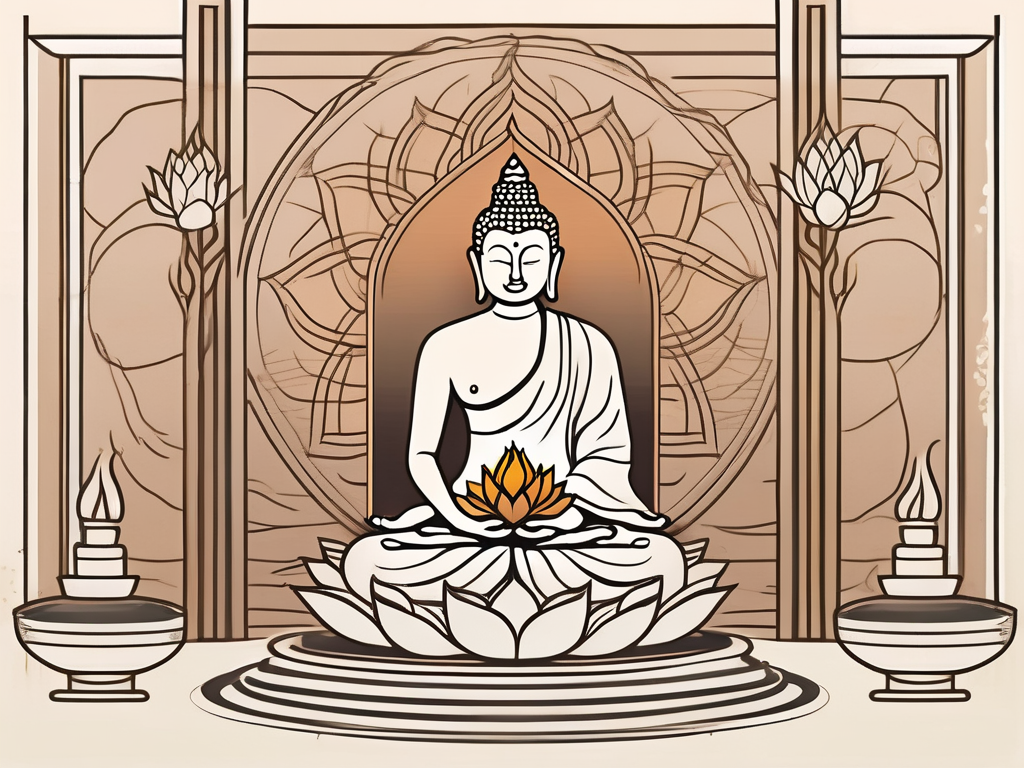Theravada Buddhism is one of the major branches of Buddhism practiced today. It originated in ancient India and has since spread to various parts of Asia. In this article, we will delve into the origins of Theravada Buddhism, exploring its key principles, the role of monks in this tradition, the birth of Buddhism itself, and the spread of Theravada Buddhism across different regions. We will also take a closer look at the teachings of Theravada Buddhism, including the Four Noble Truths and the Noble Eightfold Path. Finally, we will examine the influence of Theravada Buddhism in contemporary society and how it is being interpreted in modern times.
Understanding Theravada Buddhism
Theravada Buddhism, also known as the “Doctrine of the Elders,” is considered to be the oldest surviving branch of Buddhism. It is based on the teachings of the historical Buddha, Siddhartha Gautama, who achieved enlightenment around the 5th century BCE. The word “Theravada” itself translates to “the teachings of the elders.”
Theravada Buddhism is a rich and complex tradition that encompasses a wide range of beliefs and practices. It offers a comprehensive framework for understanding the nature of existence and the path to liberation from suffering. Let’s delve deeper into the key principles and the role of monks in Theravada Buddhism.
Key Principles of Theravada Buddhism
Theravada Buddhism revolves around certain key principles that guide its followers. These principles include the belief in the Three Jewels—Buddha, Dharma, and Sangha—as well as the concept of karma, rebirth, and the pursuit of nirvana. The ultimate goal in Theravada Buddhism is to attain enlightenment and break free from the cycle of suffering and rebirth.
The belief in the Three Jewels is central to Theravada Buddhism. The Buddha, or the awakened one, is revered as the teacher who discovered the path to liberation. The Dharma refers to the teachings of the Buddha, which provide guidance on how to live a virtuous and meaningful life. The Sangha represents the community of monks and nuns who preserve and propagate the teachings of the Buddha.
Karma, another fundamental principle, is the law of cause and effect. It states that our actions have consequences, and the quality of our actions determines the nature of our future experiences. According to Theravada Buddhism, our actions in this life and previous lives shape our current circumstances and future rebirths.
The pursuit of nirvana, the ultimate goal in Theravada Buddhism, is the liberation from the cycle of suffering and rebirth. It is the state of complete freedom from attachment, ignorance, and craving. Attaining nirvana requires deep insight into the nature of reality and the cultivation of ethical conduct, meditation, and wisdom.
The Role of Monks in Theravada Buddhism
In Theravada Buddhism, monks play a vital role. They dedicate their lives to the study and practice of the Buddha’s teachings. Monks are highly respected and seen as spiritual leaders within their communities. They follow a strict monastic code and are committed to a life of simplicity, renunciation, and meditation.
Monks undergo rigorous training to develop mindfulness, concentration, and wisdom. They engage in daily meditation practices to cultivate inner peace and insight. Through their disciplined lifestyle, they serve as living examples of the Buddha’s teachings, inspiring others to walk the path of liberation.
Monasteries serve as centers for learning and spiritual growth in Theravada Buddhism. They provide a supportive environment for monks to deepen their understanding of the Dharma and practice meditation. Monasteries also offer guidance and support to laypeople who seek to incorporate Buddhist teachings into their daily lives.
Monks often engage in various forms of community service, such as providing education, healthcare, and humanitarian aid to those in need. Their selfless acts of compassion and kindness reflect the core values of Theravada Buddhism and contribute to the well-being of society as a whole.
In conclusion, Theravada Buddhism offers a profound path to understanding the nature of existence and achieving liberation from suffering. Its key principles, including the belief in the Three Jewels, karma, rebirth, and the pursuit of nirvana, provide a comprehensive framework for spiritual growth. The role of monks in Theravada Buddhism is crucial, as they embody the teachings of the Buddha and guide others on the path to enlightenment.
Tracing the Roots of Theravada Buddhism
To truly understand the origins of Theravada Buddhism, we must delve into the beginnings of Buddhism itself. Buddhism originated in ancient India and was founded by Siddhartha Gautama, who later became known as the Buddha. Born into a noble family, Siddhartha led a life of luxury until he encountered the harsh realities of human suffering.
Seeking a solution to this universal problem, Siddhartha embarked on a spiritual quest, renouncing his privileged life and embracing a life of asceticism. For six years, he practiced extreme self-denial and meditation, seeking enlightenment and liberation from the cycle of birth, death, and rebirth.
However, Siddhartha soon realized that extreme asceticism was not the path to enlightenment. He abandoned this approach and adopted a middle way, a balanced approach between self-indulgence and self-mortification. This middle way would become one of the fundamental principles of Buddhism.
Underneath a Bodhi tree in Bodh Gaya, Siddhartha Gautama meditated deeply, vowing not to rise until he had attained enlightenment. After a night of intense meditation, he finally achieved his goal and became the Buddha, meaning “the awakened one.”
The Birth of Buddhism
The Buddha’s enlightenment marked the birth of Buddhism as a distinct religious and philosophical tradition. His teachings, known as the Dharma, formed the foundation of Buddhism. The Buddha’s insights into the nature of suffering, the causes of suffering, and the path to liberation resonated with many who sought answers to the existential questions of life.
Word of the Buddha’s teachings spread rapidly, attracting followers from various walks of life. From humble peasants to wealthy merchants, people from all social strata were drawn to the Buddha’s message of compassion, wisdom, and liberation.
The Buddha’s teachings were not confined to a particular caste or social group. He preached the universality of suffering and the potential for liberation to all beings, regardless of their background. This inclusive approach contributed to the widespread popularity of Buddhism in ancient India.
The Emergence of Theravada Buddhism
Following the Buddha’s enlightenment, he spent decades teaching and spreading his teachings. His disciples, known as the Sangha, played a crucial role in preserving and transmitting the Dharma. They traveled far and wide, sharing the Buddha’s teachings with diverse communities.
After the Buddha’s passing, his disciples carried on the transmission of his teachings, forming different schools of Buddhism. These schools developed distinctive interpretations and practices, reflecting the cultural and geographical contexts in which they flourished.
Theravada Buddhism emerged as the dominant school in Sri Lanka and Southeast Asia. Its name, Theravada, means “the way of the elders” or “the doctrine of the elders,” emphasizing the importance of adhering to the original teachings of the Buddha as preserved by the early Buddhist elders.
Theravada Buddhism places great emphasis on the monastic community and the practice of meditation. Monks and nuns dedicate their lives to the pursuit of enlightenment, following a strict code of discipline and engaging in intensive meditation practices.
Other branches of Buddhism, such as Mahayana Buddhism, gained prominence in other regions. Mahayana Buddhism emphasizes the bodhisattva ideal, the aspiration to attain enlightenment for the benefit of all beings. It encompasses a wide range of practices, including devotion, ritual, and the cultivation of compassion.
While Theravada Buddhism and Mahayana Buddhism have distinct characteristics and practices, they share a common goal: the liberation from suffering and the attainment of enlightenment. Both traditions continue to thrive and inspire millions of people around the world.
The Spread of Theravada Buddhism
Theravada Buddhism gradually spread from its roots in South Asia to other parts of the continent. This expansion was not without its challenges and triumphs, as the teachings of the Buddha faced various religious and political forces along the way.
In South Asia, Theravada Buddhism encountered a diverse range of beliefs and practices. Despite these challenges, the teachings persisted and found adherents throughout the region. Sri Lanka, in particular, became a stronghold for Theravada Buddhism, with its rich history and deep-rooted traditions. The island nation embraced the teachings of the Buddha, and today, Theravada Buddhist traditions continue to thrive in Sri Lanka.
In addition to Sri Lanka, parts of India also became centers for Theravada Buddhism. The ancient city of Sarnath, where the Buddha delivered his first sermon, became an important pilgrimage site for followers of Theravada Buddhism. Monasteries and temples were established, serving as spiritual sanctuaries for those seeking enlightenment.
Theravada Buddhism in Southeast Asia
While South Asia played a significant role in the spread of Theravada Buddhism, it was Southeast Asia that truly became a stronghold for this tradition. Countries such as Thailand, Myanmar, Cambodia, and Laos embraced the teachings of the Buddha and integrated them into their cultural and religious practices.
The spread of Theravada Buddhism in Southeast Asia was facilitated by a combination of missionary activities and the patronage of rulers. Monks traveled across the region, sharing the teachings of the Buddha and establishing monastic communities. Kings and queens, recognizing the wisdom and moral guidance offered by Theravada Buddhism, became patrons of the faith, supporting the construction of temples and monasteries.
As Theravada Buddhism took root in Southeast Asia, it became deeply intertwined with the cultural fabric of the region. Rituals and ceremonies associated with the faith became an integral part of daily life, influencing everything from art and architecture to music and dance. The teachings of the Buddha provided a moral compass for individuals and societies, guiding them towards compassion, wisdom, and inner peace.
Today, Theravada Buddhism remains a vital part of the cultural landscape in Southeast Asia. The region’s rich Buddhist heritage can be seen in the magnificent temples and monasteries that dot the landscape, as well as in the vibrant festivals and religious rituals that continue to be celebrated.
As Theravada Buddhism continues to spread its roots across the continent, its teachings offer a path to enlightenment and a source of solace for millions of followers. The journey of Theravada Buddhism, from its humble beginnings in South Asia to its flourishing presence in Southeast Asia, is a testament to the enduring power and relevance of the Buddha’s teachings.
The Teachings of Theravada Buddhism
The core teachings of Theravada Buddhism revolve around the Four Noble Truths and the Noble Eightfold Path.
The Four Noble Truths
The Four Noble Truths encapsulate the fundamental insights that form the basis of Buddhist philosophy. These truths highlight the existence of suffering, identify the causes of suffering, lay out the possibility of cessation, and provide a path to the end of suffering. Understanding and accepting these truths is considered the first step towards liberation.
The Noble Eightfold Path
The Noble Eightfold Path serves as a guide for individuals seeking to attain enlightenment in Theravada Buddhism. It consists of eight interconnected practices: Right View, Right Intention, Right Speech, Right Action, Right Livelihood, Right Effort, Right Mindfulness, and Right Concentration. Practicing these aspects of the path leads to the development of wisdom, ethical conduct, and mental discipline.
The Influence of Theravada Buddhism Today
Theravada Buddhism continues to have a significant impact on contemporary society.
Modern Interpretations of Theravada Teachings
In modern times, Theravada Buddhism has evolved and adapted to various cultural contexts. While the core teachings remain the same, new interpretations and practices have emerged. Some individuals incorporate meditation techniques into their daily lives for stress reduction and personal growth, while others engage in social activism inspired by the Buddha’s teachings on compassion and social justice.
Theravada Buddhism and Contemporary Society
Theravada Buddhism has found its place in contemporary society through the establishment of meditation centers, the promotion of mindfulness practices, and the preservation of religious and cultural traditions. It continues to provide guidance and support for those seeking spiritual fulfillment and a deeper understanding of the nature of existence.
In conclusion, the origins of Theravada Buddhism are deeply rooted in the teachings of the historical Buddha and the efforts of his disciples to preserve and transmit those teachings. Today, Theravada Buddhism is practiced and cherished by millions of individuals across the globe. Its principles, teachings, and influence continue to shape the lives of its followers and contribute to the understanding of the human condition.












